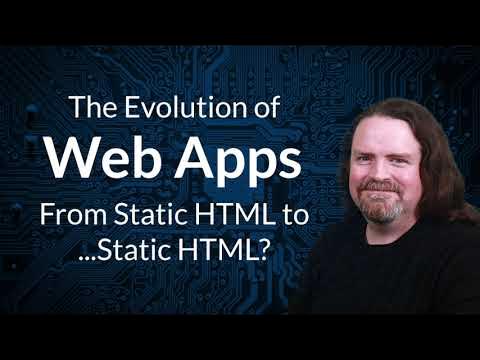How does WEB 3 Change World? What Is Web 3? | Blum Academy
Summary
TLDRThis video takes viewers on a journey through the evolution of the web, from Web 1.0's static 'read-only' era to Web 2.0's interactive 'read-write' stage, and finally to the cutting-edge 'read-write-own' world of Web 3.0. Web 3.0, built on blockchain technology, offers decentralization and digital ownership, allowing users to control their data, identities, and assets. The video also highlights the rise of NFTs and the shift from being mere consumers to active participants in the digital ecosystem. Engaging, informative, and a fun look into the web’s future.
Takeaways
- 🌐 The internet and the web are different: the internet is a network of connected systems, and the web is the content we access via browsers.
- 🛣️ Think of the internet as a highway system, while the web is a collection of rest stops and destinations along that highway.
- 🖥️ Web 1.0 (the 'Read-Only' web) featured static websites, and was primarily about consuming information.
- 🖼️ Web 1.0 sites were like digital brochures, often featuring static content and sometimes simple animations like dancing babies.
- 🤳 Web 2.0 (the 'Read-Write' web) introduced user-generated content, social media, and platforms where anyone could create and share online.
- 📊 In Web 2.0, while users became creators, large corporations started collecting and monetizing personal data, turning users into the product.
- 🔗 Web 3.0 (the 'Read-Write-Own' web) is built on blockchain technology, offering decentralized control and more personal ownership over data and digital assets.
- 💼 In Web 3.0, users can own their digital identities and assets, making it possible to carry digital personas and assets across platforms.
- 🖼️ NFTs (non-fungible tokens) allow users to own unique digital items, such as rare digital art, assets in games, and more.
- 🚀 Web 3.0 represents a major shift, where users gain control over their online experience, digital assets, and data, shaping the future of the internet.
Q & A
What is the difference between the web and the internet?
-The web, or the World Wide Web, consists of the websites and pages you visit online, while the internet is the underlying network of interconnected computers that enables the web and other services like email to function. The internet is like a highway system, and the web is like the rest stops and shops along the road.
What was Web 1.0, and how did it function?
-Web 1.0, also known as the 'read-only web,' consisted of static websites that were unchanging, like digital brochures. Users could only consume content, and interactions were limited. It was primarily about reading information, with little to no user-generated content.
How did Web 2.0 differ from Web 1.0?
-Web 2.0, known as the 'read-write web,' introduced interactive platforms like social media, blogs, and video-sharing sites. Users were able to create and share content easily, transforming the web into a more collaborative and community-driven space.
What major concerns arose during the Web 2.0 era?
-During Web 2.0, corporations began collecting vast amounts of user data from social media interactions, likes, shares, and online behavior. This data was often sold to third parties, leading to concerns about privacy and users becoming 'the product' as their information was monetized.
What is Web 3.0, and what makes it revolutionary?
-Web 3.0, also called the 'read-write-own web,' allows users to own their digital identities and assets. It is built on blockchain technology, which decentralizes control, ensuring that no single entity can alter or control the system. It promises more user control over data and digital possessions.
How does blockchain technology play a role in Web 3.0?
-Blockchain technology is the backbone of Web 3.0, functioning as a decentralized digital ledger. It allows data and transactions to be recorded transparently without being controlled or altered by any central authority. This decentralization is key to giving users more control over their online identities and assets.
What are NFTs, and how do they fit into Web 3.0?
-NFTs (non-fungible tokens) are unique digital assets, similar to owning rare physical items, but in a digital format. In Web 3.0, NFTs allow users to own digital goods, such as art, collectibles, or in-game items, with proof of ownership stored on the blockchain.
What does it mean to 'own your online persona' in Web 3.0?
-In Web 3.0, owning your online persona means having control over your digital identity and being able to use it across various platforms without being restricted by individual services or corporations. It's akin to having a digital passport that grants access and recognition across different online spaces.
How does Web 3.0 address the issues of data privacy from Web 2.0?
-Web 3.0 seeks to return control of data back to users by using decentralized systems like blockchain. Users can manage their data, decide who accesses it, and avoid the monopolistic control of large corporations that dominated Web 2.0. This shift reduces the risks of privacy violations and exploitation of user data.
What are the key differences between Web 1.0, Web 2.0, and Web 3.0?
-Web 1.0 was the 'read-only' era with static content, Web 2.0 introduced the 'read-write' model where users could create and share content on platforms like social media, and Web 3.0 is the 'read-write-own' model where users can control their data, digital identities, and assets through decentralized technologies like blockchain.
Outlines

Этот раздел доступен только подписчикам платных тарифов. Пожалуйста, перейдите на платный тариф для доступа.
Перейти на платный тарифMindmap

Этот раздел доступен только подписчикам платных тарифов. Пожалуйста, перейдите на платный тариф для доступа.
Перейти на платный тарифKeywords

Этот раздел доступен только подписчикам платных тарифов. Пожалуйста, перейдите на платный тариф для доступа.
Перейти на платный тарифHighlights

Этот раздел доступен только подписчикам платных тарифов. Пожалуйста, перейдите на платный тариф для доступа.
Перейти на платный тарифTranscripts

Этот раздел доступен только подписчикам платных тарифов. Пожалуйста, перейдите на платный тариф для доступа.
Перейти на платный тариф5.0 / 5 (0 votes)






